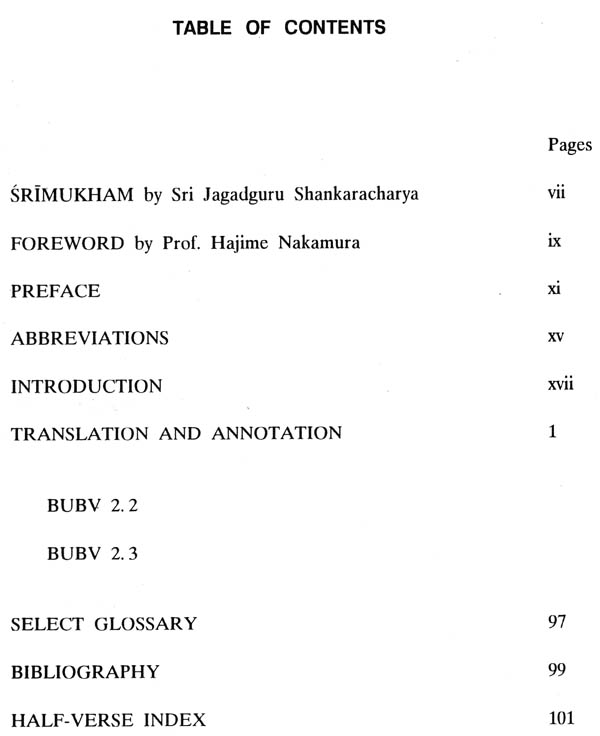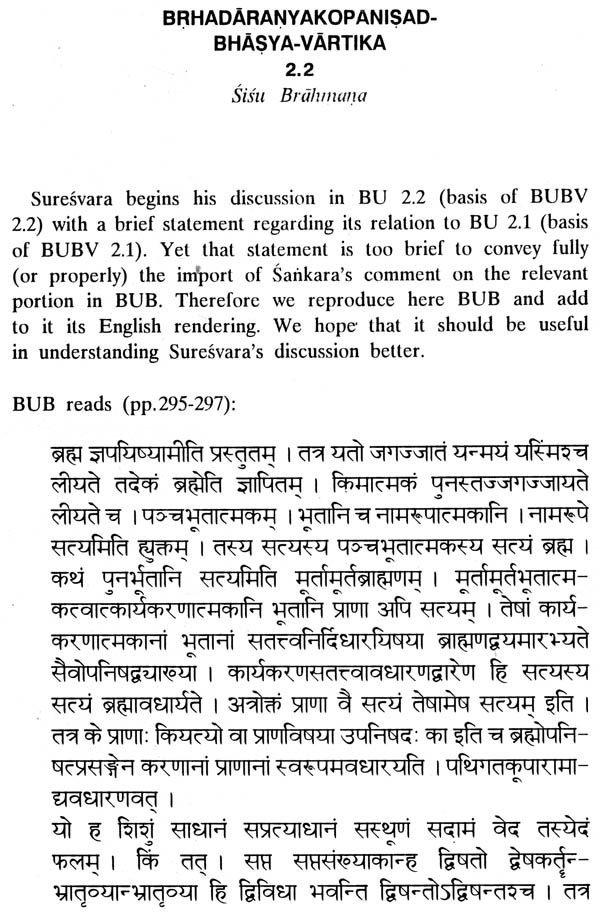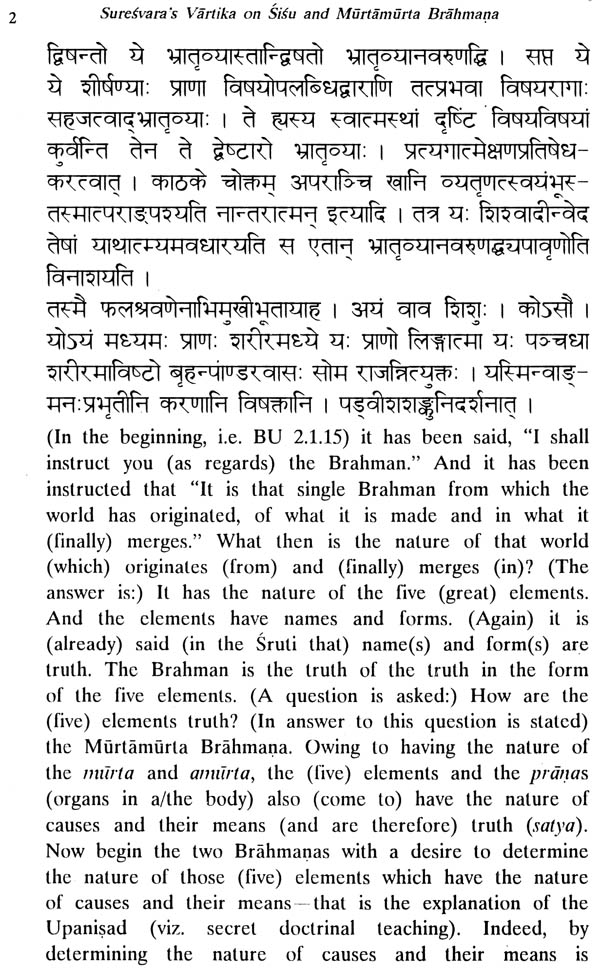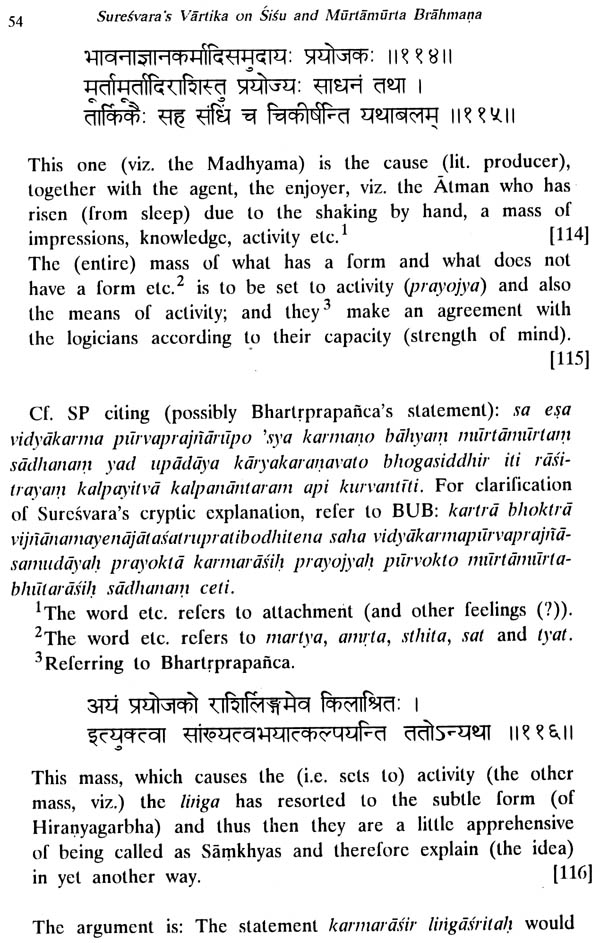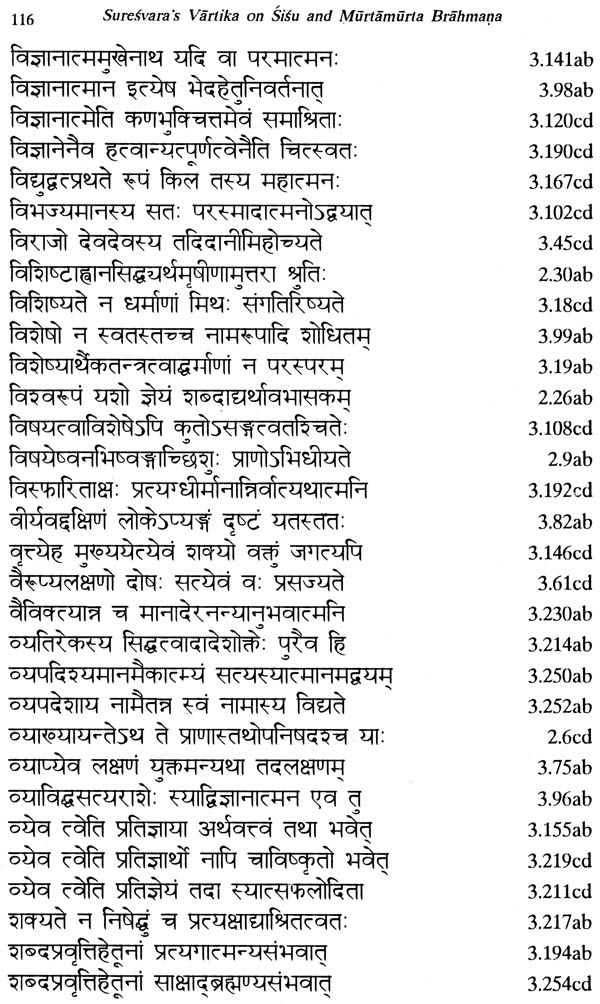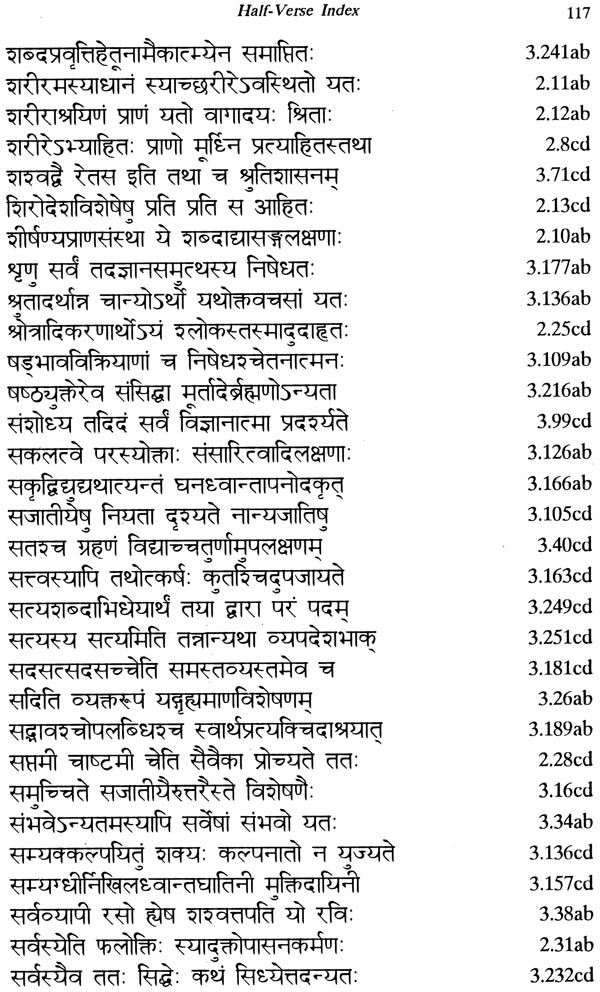
Suresvara's Vartika on Sisu & Murtamurta Brahmana
Book Specification
| Item Code: | NAU608 |
| Author: | K.P. Jog and Shoun Hino |
| Publisher: | MOTILAL BANARSIDASS PUBLISHERS PVT. LTD. |
| Language: | Sanskrit Text with English Translation |
| Edition: | 1996 |
| ISBN: | 9788120813823 |
| Pages: | 120 |
| Cover: | HARDCOVER |
| Other Details | 9.00 X 6.00 inch |
| Weight | 300 gm |
Book Description
The purport of BU (BV) 2.1 is: The Brahman alone is TRUTH and only appears as this world comprising five elements, names and forms and sense- organs (pranas) that are related as Causes and their means. Consequently, BU (BV) 2.2 and 3 explain the (real) nature of the pranas and the gods superintending over them, thereby seeking to explain prana vai satyam tesam esa satyam. Finally, it is shown how the Brahman obtains as the twofold world murta ‘what has form’ and amurta ‘what has no form’. This determines the significance of the Upanisadic teaching neti neti.
Dr. K. P. Jog
Dr. K. P. Jog is a retired Professor of Vedic Sanskrit and General Editor of Sanskrit Dictionary Project of Deccan College Research Institute, Pune.
Dr. Shoun Hino
Dr. Shoun Hino is Professor of Philosophy at Gifu Pharmaceutical University (Japan). He did his M.A. under late Prof. H. Kitagawa and Prof. Musashi Tachikawa at Nagoya University and Ph.D. studies under Prof. K.P. Jog at Poona University in 1979.
The Brhadaranyaka is the biggest and most important one among principal Upanisads and contains numerous discussions of teachers, pupils, questioners and others. It is marked by philosophical speculations not opposed to but in conformity with a vigorous performance of rituals. The Brhadaranyaka reveals to us the towering personality of the great Upanisadic thinker Yajfiavalkya who affirmed neti neti, Le. indescribability of the Brahman, the ultimate Truth. It is on this basis that Sankara built up his theory of Non-dualistic Vedanta.
Consequently, the Bhasya of Sankara on this Upanisad has assumed a very great significance in Vedantic literature. Next to his Bhasya on the Brahmastitra- nay almost on a par with it—his Bhasya on this Upanisad is a vivid picture of the (almost aggressively) vigorous philosophical acumen of the great phi- losopher. And this is more pronouncingly felt in his references to and the refutations of the arguments of the followers of other systems of Indian philosophy, for they were unavoidable for him while he clarified (in his way—on the non-dualistic way) the thought of the Upanisad from which he was distant at least by a period of about 1000 years and since there had intervened between him and the Upanisad a number of thinkers of various systems. Yet, since he had set himself to the task of commenting on the Upanisad, he inevitably became somewhat brief, leaving quite a lot of disputations unclear (for his contemporaries).
This gave his pupil Suresvara a scope for clarifying his Guru’s thought in its fullness and he wrote the Brhadaranyakopanisad- bhasyavartika. The last member of the compound-name, vartika, refers to Sureévara’s discussion of ukta, anukta and durukta portions in Sankara’s writing. Suresvara has underlined every small detail in the varied arguments in the Bhasya on the Upanisad and clarified the same with characteristic skill. It is noticed that Sureévara is familiar with minute details of different philosophical systems—Nyaya and Mimamsa, in particular—and therefore he has in a way shaped the Tika of Anandagiri, the most read commentator of Sankara’s works, thus throwing abundant light on the vigorous philosophical activity of the times which preceded his teacher Sankara and himself.
A special mention has to be made here of Suresvara’s detailed discussions of the views of Bhartrprapafica, a predecessor or a senior contemporary of Sankara. It may become possible for us, now, to set up a somewhat understandable scheme of Bhartrprapajica’s philosophy on the basis of these. Another significant contribution of Suresvara deserves special notice. His discussions about the interpretation of Vedantic passage (implying Mimamsa) and various means of understanding/knowledge (implying Pramanavyavahara or Nyaya) in relation to the Vedantic logic indeed deserve in-depth studies for purposes of clarifying the method of Non-dualistic Vedanta.
The Vartika of Suresvara on the Brhaddranyakopanisad is truly his magnum opus and needed to be translated in full. I feel happy that Prof. K.P. Jog and his worthy pupil Dr. Shoun Hino have undertaken this important task. I have gone through the earlier parts of this work and find that they have well attempted to secure a satisfactory translation. This translation, I cannot forget to add, is accompanied by some brief annotation on the same. For this work Dr. Hino was awarded the 1991 Eastern Study Prize by the Eastern Institute, Inc. at the Indian Embassy in Tokyo.
Our translation of Sisu and Murtamirta Brahmana 2.2 and 2.3 in BUBV goes to the press somewhat late and_ before Ajatasatru Brahmana; this is owing to the sudden and quite a prolonged illness of K. P. Jog. Consequently, our introduction to BUBV 2.2 and 3, which depends much on the earlier Brahmana, viz. AjalaSatru Brahmana is bound to be (in some measure) deficient. It takes for granted what is (or, will be) said in the introduction to that Brahmana; it relates more to the textual details than to the problems involved. That is to say, it is not clarified herein how BU (or, BUBV) 2.2 and 3 do not present any significantly positive philosophical thoughts in addition to those in BU (or, BUBV) 2.1; they merely amplify, by adding explanatory details, the thought in the latter.
A few words about our translation may not be unnecessary. There is inherent difficulty in rendering into very simple English structure the slightly (and comparatively) truncated or complex Sanskrit structure; we have yet tried at a number of places to simplify the same by avoiding as much literal English rendering as in the earlier parts of our series.
As usual our friends and colleagues in the Deccan College, Pune have helped us in tracing some citations. We acknowledge gratefully their help. We express our special thanks also to Prof. K. Macida (ILCAA), Prof. J. Takashima (ILCAA) and Mr. N. Okaguchi. Prof. Macida is a developer of Devanagari printing software called CATUR, which has been used in preparing our books, and Mr. Okaguchi is a Devanagari font designer.
We hope to put into our readers’ hands the work on BUBV 2.1 at some early date.
We -have already stated in the Preface how BUBV 2.2 and 3 go merely to amplify, by adding explanatory details, the thought in BUBV 2.1. This becomes clear in the light of the synoptic contents of the two Brahmanas under translation in this part of our work. (These are given below).
But first, it is necessary to record here that BUBV 2.1.20 stated that the vital force is a/the body, which is the Atman namely, the inner self— is the (basic or ultimate) truth of the pranas ‘organs’ which are described as truth (Read: etasmad atmanah sarve pranah sarve lokah sarve devah sarvani bhutan vyuccaranti ... prand vai satyam tesam esa satyam). Therefore, BU 2.2, which seeks to clarify the nature of the Atman, i.e. the inner self, describes it figuratively as sis ‘a young one’ bound by physical bonds or, to speak precisely, the limiting adjuncts of the same. Also, it reveals the secret names of the Self. Naturally, therefore, BU 2.2 is called Sigsu Brahmana.
Then BU 2.3 goes to describe the two forms of the same Brahman (i.e. the inner self) in order to explain its secret names and its so-called composition which does not belie its description as the truth of the truth. The Brahman is here described as (i) having forms (uirta) and (ii) not having any form whatever (anurta). It (viz. which is muirta) is then described as mortal (martya), limited in point of time and place (sthita), existent as distinct objects (sat) and finally that (tyat), viz. beyond description. The same is again described as comprising the perceptible (three in number) and imperceptible (two in number) elements (b/itas). The adhyatma ‘with reference to a/the body’ and adhidaivata ‘with reference to deities’ forms also are well determined —this, in relation to three elements, viz. Prthivi, Ap and Tejas (murta) and that in relation to the remaining two elements, viz. Wind and Sky (amurta). Finally, the form of that Purusa ‘being’ is revealed (with the help of examples) which leads to the proper philosophical and true description of its name also, and to the instruction (a@desa) about its nature in the words neti neti. All this is significantly called Murtamurta Brahmana. This Brahmana, viz. 2.3, is comparatively longer than its preceding and, as a result, BUBV 2.2 is shorter than BUBV 2.3. This should become clear from the following synopsis of their contents.
BUBV 2.2:
In the beginning, Suresvara brings out (in verses 1-7) how there is continuation of the thought of BUBV 2.1. Then he explains (in verses 8-15ab) the meaning of the first section of BUBV 2.2. He supplements to this explanation the interpretation of the word sasthtinam offered by a pre-Sankara Vedantin Bhartrprapafica (in verses 15cd-21). He explains the second section (in verses 22-24) and the third section (in verses 25-29). He explains the fourth section (in verses 30 and 31).
This shows how brief is Suresvara’s explanation of BUB. It is not necessary to present here the details of a comparative discussion about BUB and BUBV. It is necessary to point out, nevertheless, that Suresvara avoids many of the details in BUB on section four. Possibly, he does not appear to notice any significant philosophical points revealed in them.
BUBV 2.3:
Suresvara pays, it seems, greater attention to the introduction to the Brahmana (verses 1-14). He explains only minutely the purport of the first section (in verses 15-34) and thus clarifies the significance of the different concepts—or, rather, adjectives murta, martya etc.—in relation to the ‘elements’. Then (in verses 35-44) he brings out, by way of explaining the words muirta, martya, sthita and (finally) sat in relation to the three elements Prthivi etc. in the second section. He explains thereafter (in verses 45-48) the purport of the third section, stressing the meaning of Mandala, i.e. Hiranyagarbha. Incidentally, following Sankara’s very briefly worded view of Bhartrprapajica (in BUB) regarding the BU sentence tyasya hy esa rasah, he presents the same (in verses 49-58ab) and then gives blame to it, by pointing out the faults involved in the same (in verses 58cd-68) at length; this is in relation to the deities connected therewith (adhidaivata).
